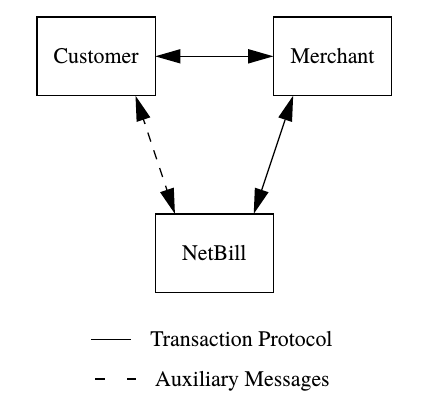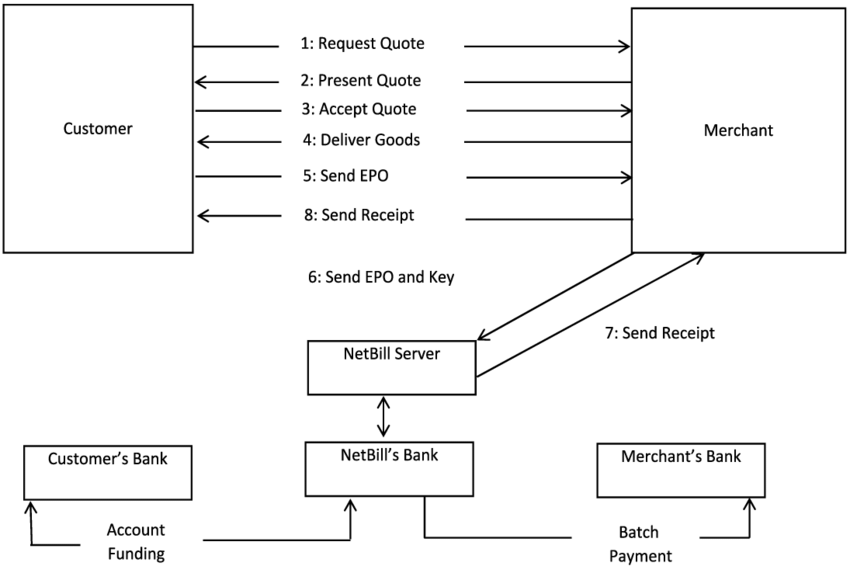What is NetBill? [From Original Paper]
NetBill is a system for micropayments for information goods (digital commodities) on the Internet. A customer, represented by a client computer, wishes to buy information from a merchant’s server. An account server (the NetBill server), maintains accounts for both customers and merchants, linked to conventional financial institutions. A NetBill transaction transfers information goods from merchant to customer, debiting the customer’s NetBill account and crediting the merchant’s account for the value of the goods. When necessary, funds in a customer’s NetBill account can be replenished from a bank or credit card; similarly, funds in a merchant’s NetBill account are made available by depositing them in the merchant’s bank account.
NetBill requires an efficient set of protocols to support price negotiation, goods delivery and payment.
The NetBill Transaction Model [From Original Paper]
The NetBill transaction model involves three parties: the customer, the merchant and the NetBill transaction server. A transaction involves three phases: price negotiation, goods delivery, and payment.
Transaction Objectives [From Original Paper]
For a NetBill transaction, we have the following set of objectives.
a) Only authorized customers can charge against a NetBill account.
b) The customer and merchant must agree on the item to be purchased and the price to be charged.
c) A customer can optionally protect her identity from merchants.
d) Customers and merchants are provided with proof of transaction results from NetBill.
In addition, we have the following objectives to support price negotiation and goods delivery.
e) There is an offer and acceptance negotiation phase between customer and merchant.
f) A customer may present credentials identifying her as entitled to special pricing or treatment.
g) A customer receives the information goods she purchases if and only if she is charged (and thus the merchant is paid) for the goods.
h) A customer may need approval from a fourth (access control) party before the NetBill server will allow a transaction.
Finally, we add as a general objective for all phases of the purchase process:
i) The privacy and integrity of communications is protected from observation or alteration by external parties.
Transaction Protocol Overview [From Original Paper]
In the price negotiation phase, the customer presents evidence of her identity, and (optionally) supplemental credentials, and requests a price quote on an item. The customer may also include a bid for the item. The merchant responds with a price offer.
In the second phase, the customer accepts or declines the offer. In the case of information goods, acceptance constitutes an order for network delivery. The merchant provisionally delivers the goods, under encryption, but withholds the key.
Key delivery is linked to completion of the third phase, the payment protocol. In this phase, the customer constructs, and digitally signs, an electronic payment order (or EPO) and sends it to the merchant. The merchant appends the key to the EPO and endorses (digitally signs) the EPO, forwarding it to the NetBill server. The NetBill server returns a digitally signed receipt, which includes the key, to the merchant, who forwards a copy to the customer.
- C ⇒ M Price request
- M ⇒ C Price quote
- C ⇒ M Price quote Goods request
- M ⇒ C Goods, encrypted with a key K
- C ⇒ M Signed Electronic Payment Order
- M ⇒ N Endorsed EPO (including K)
- N ⇒ M Signed result (including K)
- M ⇒ C Signed result (including K)
In this project me (Navid Malek) and my fellow friend Reza Rahimi implemented most of NetBill transaction protocol, including:
- Transaction Protocol
Paper Sections
3.2. The Price Request Phase
3.3. The Goods Delivery Phase
3.4. The Payment Phase
- Error recovery (Not enough balance, Courruption, No access, etc.)
- Pseudonyms Protocol
Paper Sections
4.2. Pseudonyms
- Access Control Mechanism
Mini Access contol app not According to paper
Approach
Our main focus was to implement the protocol, so the approach we take was to use intermediary files that act as Sockets; hence, for various steps of protocol istead of writing data into socket and read from it, we have used files. In the next section, I have provided more details about the files and codes presented.
TicketGenerator.py ==Written by Navid==> Generating MIT Kerberos ticket for merchant or netbill server
Pseudonyms.py ==Written by Navid==> Pseudonym phase or simple true identity ticket generation
AccessControl.py ==Written by Navid==> AccessControl mini App
customer.py ==Almost all of it written by Reza==> customer app for transaction phase
merchant.py ==Almost all of it written by Reza==> merchant app for transaction phase
netbill-server.py ==Almost all of it written by Reza==> netbill-server app for transaction phase
.json files act as data bases, for example products.json is a simple data base for products
accessList.txt is a simple acces control list, anyone in the list is authorized to buy
.key files are various symmetric keys used in protocol's phases; for instance, K1.key and K2.key are the keys used in Pseudonyms phase with the same name in original paper's description
.pem files are the asymmetric keys; for instance, PV_C.pem is the private key of customer
other .txt files are mainly the intermediary files
//TO DO add more comments on files
Python 3
Python 3 crypto and system libraries
MIT Kerberos server and client
Bash Shell
Tested on ubuntu ( should be fine in all Linux distros )
-
run the following command in terminal: git clone https://github.com/navidpadid/NetBill_Transaction_Protocol/
-
run the codes
Here are various scenarios which I've ran the code from a fresh clone of repository.
Some scenarios include: with/without pseudonyms, with/without access to buy, with/wihtout NetBill account, with/wihtout enough credits to buy a commodity.
Watch it here: https://www.aparat.com/v/YfZAw
Blog Post: http://navidmalek.blog.ir/1398/07/11/Netbill-Transaction-Protocol-Simulator

